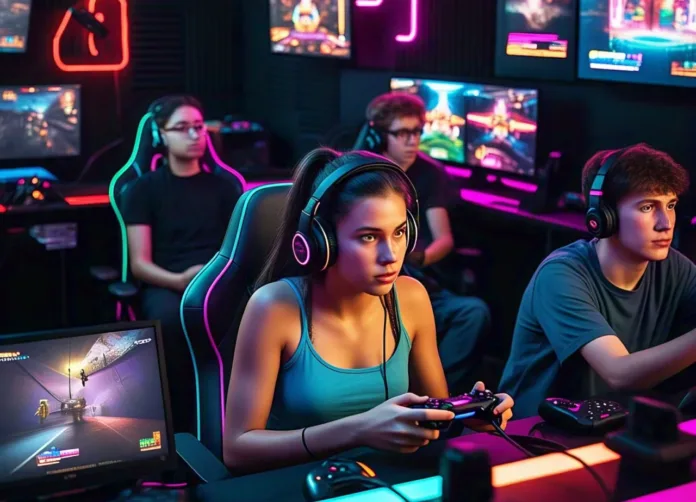The Article Tells The Story of:
- Video Games Build AI’s Foundation — Gaming hardware paved the way for today’s AI breakthroughs.
- Game Engines Train Robots Before the Real World — Virtual simulations create smarter, safer robots.
- VR, AR, and Real-Time Movies Emerge from Gaming Tech — Gaming tools now power Hollywood and immersive worlds.
- Virtual Worlds Become Human Labs — Scientists study behavior through massive online gaming experiments.
Video Games Paved the Way for Modern AI Technology
Video games built the modern world by demanding better hardware. In the 1990s, companies like NVIDIA created graphics cards such as the Riva TNT, designed for gamers who wanted realistic visuals. Over time, the same technology proved perfect for building artificial intelligence.
Graphics cards made for gaming solved problems around rendering complex images quickly. These same cards, known for their ability to handle parallel processing, turned out to be excellent at simulating neural networks. Without the push from gamers demanding faster, better graphics, AI research would not have advanced so quickly.
Ordinary programs like word processors or web browsers do not require extreme hardware. It was gaming’s constant hunger for more power that forced chip makers to innovate. This relentless pressure helped the computer industry develop the powerful tools we now use to build smart machines, robots, and autonomous systems.
Read More About Our Article of Atari 2600: How One Console Built an Empire—and Then Crashed It Published on April 22, 2025 SquaredTech
Gaming Engines Power Robots, Films, and Virtual Reality
Another major way video games built the modern world is through their engines. Video game engines like Unreal Engine evolved to simulate complex physics, lighting, and interaction between objects. Today, these engines do more than create games.
Roboticists use gaming engines to train robots in virtual environments. Instead of risking expensive real-world tests, developers run thousands of simulations, allowing virtual robots to learn tasks before transferring their skills to physical machines. Without gaming tech, the robotics boom would have moved much slower.
Game engines also changed how Hollywood works. On productions like The Mandalorian, filmmakers used LED walls and real-time rendering from gaming engines instead of green screens. This method saves time, reduces post-production costs, and gives actors a better sense of their surroundings.
Gaming engines have even impacted architecture. Architects use real-time graphics to walk clients through virtual buildings before construction begins. This technology offers immediate feedback and visualization that blueprints never could.
Modern virtual reality (VR) and augmented reality (AR) also owe everything to gaming. Games perfected 3D graphics, motion tracking, physics simulations, and controller design. VR headsets, AR glasses, and their software ecosystems all grew directly out of the gaming industry’s breakthroughs.
Gaming Interfaces Shaped Real-World Tools and Society
Video games taught people how to manage information quickly and make split-second decisions. As a result, video game interfaces heavily influenced modern tools.
Infotainment systems in cars, drone controllers, and military equipment now use interface designs inspired by gaming. Modern camera drones use controllers almost identical to gamepads, offering intuitive control based on designs people know from years of playing games.
Gamification, a concept born from video game design, also reshaped marketing, education, and workplaces. Loyalty programs, online learning platforms, and fitness apps all use reward systems and achievement tracking inspired by video games. These systems tap into people’s natural desire for progress, rewards, and recognition.
Gamification encourages customer loyalty, improves learning retention, and motivates employees. Without the influence of video games, these behavioral strategies might never have taken off outside entertainment.
Virtual Worlds Offer New Ways to Study Human Behavior
Video games also built the modern world by creating opportunities for science. Virtual worlds provide a unique platform for researchers studying human behavior.
Large multiplayer games like World of Warcraft allow scientists to observe human actions in ways never possible before. For example, researchers used a virtual disease outbreak in World of Warcraft to study pandemic behavior. The way players reacted to the “Corrupted Blood” incident offered valuable insights for real-world public health planning.
Virtual spaces let scientists safely run experiments without harming participants. Researchers can see how people cooperate, form groups, or respond to challenges. As society moves deeper into digital life, virtual worlds may help us better understand ourselves—and prepare for future social changes driven by technology and AI.
Final Thoughts: How Video Games Quietly Built the Modern World
Video games built the modern world by pushing the limits of hardware, software, and human behavior. They drove the development of AI through the need for better graphics cards. They made VR, AR, and robotics possible through powerful engines and interfaces. They changed how we design movies, cars, and workplaces.
Most importantly, video games offered researchers a glimpse into human nature in ways the real world could not. From their earliest days with simple titles like Pong and Space Invaders, video games sparked revolutions across industries.
Today, the impact of video games stretches far beyond entertainment. They have helped shape the tools, systems, and technologies that define modern life—and they will continue to shape the future.
Stay Updated: Gaming


